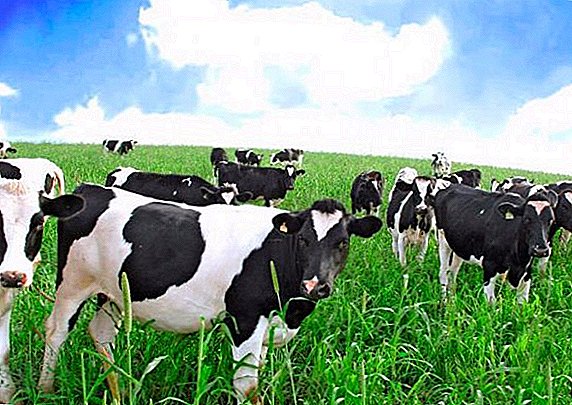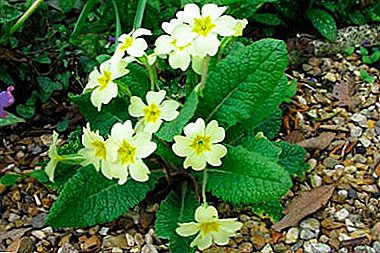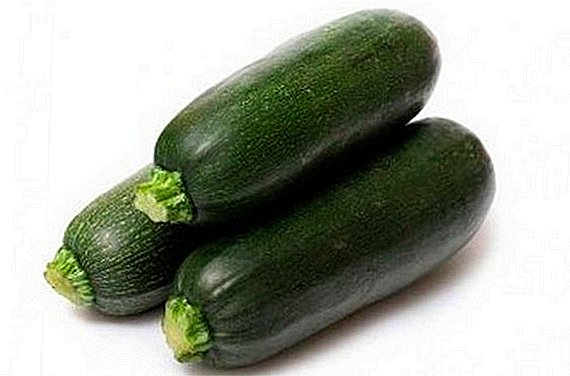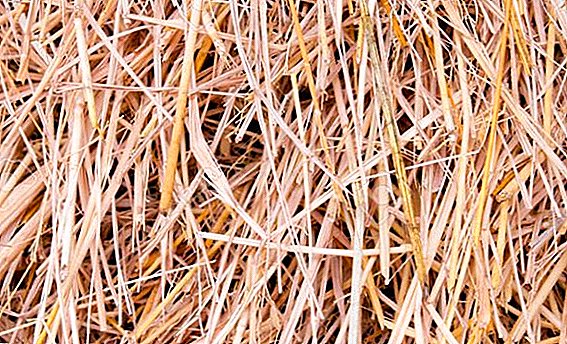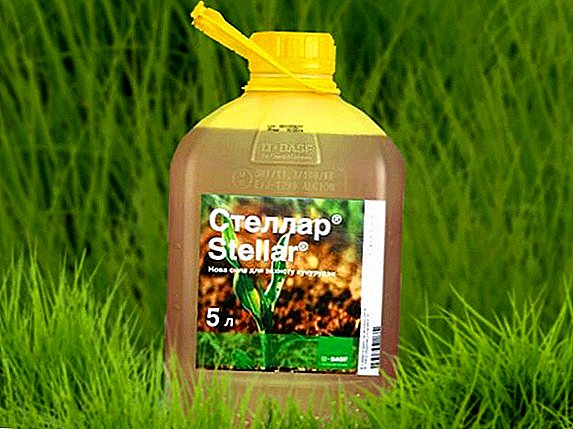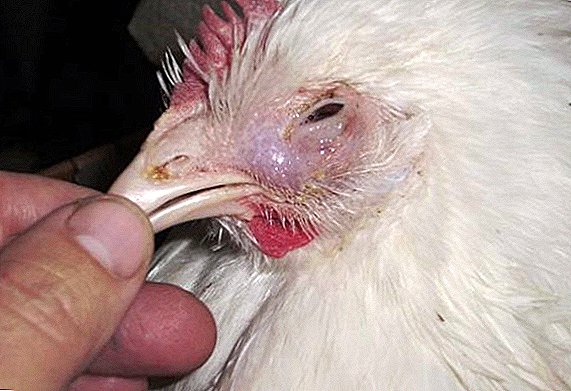 Every farmer, undoubtedly, wishes that all birds and animals living in his farm have strong immunity and are healthy. However, the desired does not always coincide with the actual, and often, entering the hen house, the poultry farmer hears his broilers sneezing and wheezing. How to help birds with colds and infectious diseases and how to prevent their occurrence - let's look at the article.
Every farmer, undoubtedly, wishes that all birds and animals living in his farm have strong immunity and are healthy. However, the desired does not always coincide with the actual, and often, entering the hen house, the poultry farmer hears his broilers sneezing and wheezing. How to help birds with colds and infectious diseases and how to prevent their occurrence - let's look at the article.
Causes of respiratory diseases in broilers
As a reckoning for a quick weight gain and a lot of weight, broilers got a lot of negative qualities during selection, including a predisposition to various kinds of diseases. Therefore, respiratory diseases in these chickens are not uncommon. The reasons for their occurrence may be several:
- improper care;
- violations of conditions of detention, sanitary standards;
- non-compliance with recommendations on density of placement;
- unbalanced feeding;
- hypothermia;
- lack of oxygen in the air;
- infection in the chicken coop with food, water, new stock;
- intrauterine infection.
Causes of wheezing can also be a foreign body in the beak and throat.  Particularly high risk of developing diseases in boilers arises from birth to 5 days of life, from 20 to 25 days and from 35 to 40 days.
Particularly high risk of developing diseases in boilers arises from birth to 5 days of life, from 20 to 25 days and from 35 to 40 days.
Important! Usually, diseases in chickens occur rapidly - even in the evening, cheerful and cheerful birds in the morning can already wheeze, and after a couple of days fall lifeless. Therefore, when the first symptoms are found, treatment should begin immediately.
Possible diseases
Symptoms such as wheezing, rapid breathing, sneezing, coughing are accompanied by several diseases. In this section you will find information about the most common treatment methods.
Cold
The cause of colds is hypothermia. Broilers are very sensitive to temperature drops, temperature shocks, drafts and dampness.
Find out what is the reason and how to solve the problem of underweight in broilers.
The disease manifests itself with the following symptoms:
- fever;
- decrease in motor activity;
- refusal to eat;
- sneezing;
- cough;
- hoarse breathing;
- redness and swelling of the eyelids;
- discharge of mucus from the nose and eyes;
- shortness of breath;
- heart palpitations.
 The next step will be an invitation or a remote consultation of the veterinarian, who will help determine the causes of the disease and prescribe proper treatment.
The next step will be an invitation or a remote consultation of the veterinarian, who will help determine the causes of the disease and prescribe proper treatment.Did you know? The word "broiler" comes from the English "broil", which translated means "to fry." This name chickens received due to the fact that they are specially grown with a large mass for eating. A large weight of a bird is achieved in a very short period of time - in only 2 months they can weigh about 2 kilograms or more, moreover, that an ordinary chicken at this age weighs only half a kilo. Adult broilers reach the weight of a turkey - 5-6 kg.
Infectious bronchitis
Infectious bronchitis was isolated in a separate disease in 1930 by American veterinarians. His symptoms are identical with a cold - sneezing, discharge of mucus from the eyes, increased breathing, coughing, wheezing. However, bronchitis develops rapidly and is very dangerous for young birds, for 25% of which can end fatally. It may also be accompanied by a curvature of the neck, constantly lowered wings, green diarrhea. Adults are stunted, stop gaining weight. Mortality among mature birds is negligible.  Deformation of the shell of eggs characteristic of infectious bronchitis Today, there are about 50 strains of this disease. The virus, which stimulates bronchitis, is transmitted by airborne droplets through food, water, clothing and equipment. A bird that has had viral bronchitis may carry the pathogen for another 100 days.
Deformation of the shell of eggs characteristic of infectious bronchitis Today, there are about 50 strains of this disease. The virus, which stimulates bronchitis, is transmitted by airborne droplets through food, water, clothing and equipment. A bird that has had viral bronchitis may carry the pathogen for another 100 days.
Newborn chickens may already have a virus in their bodies if they hatched from an egg laid by a sick layer.
Most often outbreaks of infectious bronchitis are observed in spring and summer. In order to reliably establish the diagnosis, blood samples and tracheal and larynx scrapings are taken from chickens.
Did you know? In broiler meat contains 92% of the necessary human amino acids. For comparison - in their pork 89%.
Bronchopneumonia
Another respiratory disease is bronchopneumonia. Sick broilers look unkempt, disheveled, unhealthy, are in a wilted state, move a little, eat poorly, breathe hoarsely, cough and sneeze.  Bronchopneumonia with delayed treatment can be fatal. It is also dangerous because, by significantly reducing immunity, it entails other diseases - tracheitis, mycoplasmosis, rhinitis.
Bronchopneumonia with delayed treatment can be fatal. It is also dangerous because, by significantly reducing immunity, it entails other diseases - tracheitis, mycoplasmosis, rhinitis.
Check out the common infectious and non-infectious diseases of broiler chickens.
Mycoplasmosis
Mycoplasmosis is a respiratory disease that is bacterial in nature. It is excited by mycoplasma gallisepticum, which is carried by airborne droplets from mother to child. The disease is characterized by strong wheezing in birds. Also symptoms of respiratory mycoplasmosis include shortness of breath, loss of appetite, growth retardation.
Colibacteriosis
Chickens can sneeze and wheeze during colibacillosis. Most often it affects small chickens. It is excited by E. coli, which is transmitted through feed, water and aeration.
It is useful to learn about the main symptoms and treatment of colibacillosis in poultry.
The treatment of colibacillosis at the stage of wheezing should be made immediately, because if this symptom is also associated with diarrhea, it may be ineffective. Rattles are treated with antibiotic therapy, usually "Levomitsetinom."  Sick birds should be quarantined and the chicken coop sanitized. Chlorine turpentine can be used for disinfection. Healthy birds need to be drunk with the Furacilin solution (1: 10,000) and enter vitamins and minerals in their menu.
Sick birds should be quarantined and the chicken coop sanitized. Chlorine turpentine can be used for disinfection. Healthy birds need to be drunk with the Furacilin solution (1: 10,000) and enter vitamins and minerals in their menu.
How to treat respiratory diseases in broilers
If respiratory symptoms are detected, the following steps should be performed immediately:
- To organize a quarantine and put diseased birds into it.
- Inspect them for any symptoms.
- Contact your veterinarian.
- Start prescribed treatment.
- Disinfect the room.
If it is not possible to contact a veterinarian, you should:
- To powder the nose of birds "Streptocide."
- To feed the birds with preparations with such main active substances - tetracycline, levomycetin. Medicinal products are diluted in water in accordance with the recipe and allowed to drink to the birds.
- To produce inhalation with essential oils (fir, eucalyptus).
- Water feathered instead of water nettle decoction.
Bronchopneumonia is treated by spraying ashpieptol (350 g of soda, an aqueous solution of bleach (1 cup / 7 l of water), after infusing to bring to a volume of 20 l), using antibiotics: penicillin, terramycin, norfloxacin, colistin, enrofloxacin.
Find out what are the causes of death of broilers.
In the event of any of the diseases, diseased and healthy birds should be separated and immediately disinfected with formaldehyde (0.5%), hot soda (3%), and chlorine-containing lime (6%). In the diet of sick chickens should include more vitamins and minerals.  To cure mycoplasmosis, boilers should be watered with water with the addition of antibiotics enrofloxacin, tiamulin, tylosin. Usually, veterinarians advise one of the following drugs: Farmazin, Tilan, Pneumotil, Enroxil and others.
To cure mycoplasmosis, boilers should be watered with water with the addition of antibiotics enrofloxacin, tiamulin, tylosin. Usually, veterinarians advise one of the following drugs: Farmazin, Tilan, Pneumotil, Enroxil and others.
For the treatment of colibacillosis used "Gentamicin", "Tetracycline", "Polymyxin", "Furagin".
Antibiotic therapy is prescribed for at least 5 days. Simultaneously with antibiotics should be added to food and probiotics.
Important! Since the symptoms of many diseases are identical, then you should not engage in self-treatment of birds. The correct diagnosis can only be established by a veterinarian, therefore it is important to always have on hand the contacts of a competent specialist who can advise you at least by telephone.
How to prevent respiratory diseases of broilers
There are 2 ways to keep the chicken coop from getting infected:
- carry out timely disinfection of the premises;
- implement preventive measures.
How to disinfect
Disinfection is carried out in order to destroy pathogens and harmful insects - ticks and fleas. There are different recommendations on how often to produce it: some sources say that it is enough to do it once a year, others say that it should be done at least once every 2 months, and once a year should be carried out cleaning The number of procedures will depend on the size of the house and the number of livestock.  Sanitation of the chicken coop includes 3 stages:
Sanitation of the chicken coop includes 3 stages:
- cleaning;
- washing;
- disinfection.
During the cleaning, bedding, food residues, feces, feathers are completely removed. Both floor and perch are cleaned. It is necessary to carefully scrape all residues, otherwise disinfection will be ineffective.
Important! During work, in order to avoid dust and bacteria entering the body, a person must protect the respiratory tract with a mask, eyes with glasses, hands with gloves.After cleaning all debris, the coop should be washed. This can be done using a cloth and a bucket, and spraying a hose. Sink should be carried out by special means intended for poultry houses. Household chemicals for these purposes will not work, because it can be toxic to birds. In the absence of special equipment used apple cider vinegar - it is diluted in water in a ratio of 3 to 2.
 Sanitation is also carried out by specialized means or those that are at hand. The first are antimicrobial, antiviral and antifungal aerosols:
Sanitation is also carried out by specialized means or those that are at hand. The first are antimicrobial, antiviral and antifungal aerosols:- "Monklavit";
- "Bactericide";
- "Virucide";
- "Glutex".
The so-called improvised means for disinfection include the two mixtures described below.
The first disinfectant is prepared by mixing hydrochloric acid and potassium permanganate (5 to 1). Put it in a hen house and incubate for 30 minutes, then the room is well ventilated.
Read more about the types and means for disinfecting the chicken coop.
The second tool is prepared by mixing crystalline iodine (10 g per 20 cubic meters of area), aluminum powder (1 g to rub) in ceramic dishes, and 1.5 ml of water. Means kept in the room for 30 minutes, then produce airing.
It is also possible to carry out sanitation with formaldehyde. However, this tool is recognized in Europe as a carcinogen, so it is better to give preference to more modern methods.
Another commonly used disinfectant is bleach.  Do not forget that not only the house has been reorganized, but also the feeders, nests and drinking bowls. After work, all inventory involved in the rehabilitation is disinfected.
Do not forget that not only the house has been reorganized, but also the feeders, nests and drinking bowls. After work, all inventory involved in the rehabilitation is disinfected.
How to carry out prevention
Prevention consists in:
- observance of sanitary standards in the hen house, maintaining cleanliness, dryness and fresh air, temperature for very young chickens (1 week old) at the level of + 32-33 ° С, for more adults - not less than + 18 ° С, humidity at the level of 55-70 %;
- insulation and equipment of the room where birds are kept, heaters and a good ventilation system;
- maintaining an air concentration of at least 17%;
- compliance with the standards of the population of the house - it is recommended to contain no more than 10-15 chickens per 1 square. m without ventilation and 20-25 individuals in the house with a ventilation system;
- Ensuring that birds do not overcool, do not succumb to drafts;
- timely vaccination;
- introduction to the diet of vitamins and minerals.
Did you know? Broilers reach more weight than regular chickens, in a short time, but at the same time consume much less feed. The reason lies in the larger intestines and faster metabolism.
So, broilers have a significant drawback - a weak immune system, so they have respiratory infectious diseases - not uncommon. It is important to notice the symptoms in time, contact the veterinarian for diagnosis and prescription of drugs and begin treatment procedures. To prevent the death of poultry from infectious and colds, follow the guidelines for their maintenance, keep the hen house clean, make the right diet, and take other preventive measures.


